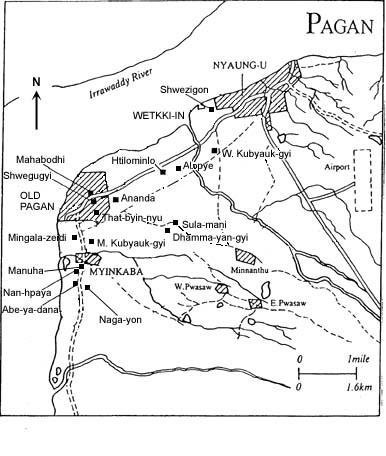
|
Temples of Pagan: A Selection
in chronological order
1: Nanpaya, mid-11th century
(3)
2: Manuha, c. 1060
(3)
3: Nagayon, c. 1090
(5)
4: A small shrine, near Abeyadana
(2)
5: Abeyadana, 1084-1113
(2)
6: Shwezigon Paya, 1102
(7)
7: Ananda Temple, 1105
(12)
8: Myinkaba Gubyaukgyi, 1113
(2)
9: Alopye Temple, early 12th century
(3)
10: Thatbyinnyu, mid 12th century
(1)
11: Dhammayangyi, c. 1165
(1)
12: Sulamani, 1183
(7)
13: Htilominlo, c. 1211
(3)
14: Wetki-in Gubyaukgyi, 1211-1234
(1)
15: Mingala zedi, 1277
(3)
See also: Rulers and Monuments
Table
|
Pagan is located on a bend of the Irrawaddy River,
about 100 miles southwest of Mandalay, in the middle of Burma's
dry zone (map). Inhabited since the
mid-9th century, Pagan developed into an empire that
unified Burma under the military conquests of King
Anawrahta ("ann-ARE-uh-tuh", 1044-1077). Anawrahta
also made Theravada Buddhism the state religion, and began an
extensive program of temple-building that lasted, like the Pagan
Dynasty itself, until the Mongol conquest of 1287. During this time
the Khmer empire (800-1300) was also flourishing to the east, but
did not impinge on Pagan due to the presence of Thai buffer states
between them.
Cultural influences on Pagan include India and Ceylon.
Anawrahta considered himself to be a chakravartin (universal
monarch) on the Ashokan model, imported Brahmins from India
to fill administrative roles at court, and initiated religious
and diplomatic exchanges with Ceylon. Buddhism itself was
never very concerned with secular matters, so ideas of governance
(including administration and court ritual) had to be imported
from Hinduism. Ideologically, according to Strachan (p. 10),
the kings of Pagan considered themselves to be avatars of Vishnu
in the service of Buddha – if true, this is a rather unusual theology that would repay much closer academic study.
The site today contains 2,217 individually identified monuments
(Strachan, p.1),
all of them Buddhist, scattered in an area of approximately 40 square miles around a half-dozen villages on the plain.
As of 2018, Pagan has applied but not yet been designated as a World Heritage Site. Nevertheless, dozens of impressive restored
temples and stupas, many with beautiful
interior carvings and murals, can be visited. Photography
of the paintings is not generally permitted, but a good selection
can be seen in Claudine Bautze-Picron's book, The Buddhist Murals of Pagan: Timeless Vistas of the Cosmos.
Recommended websites about Pagan:
The Art and Culture of Burma: Chapter 3 (Richard Cooler)
Asian Historical Architecture: Bagan (Robert D. Fiala and other contributors)
Bagan (Jean-Claude Morin and Yves Michel)

